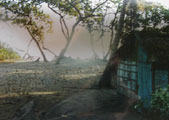Logwood Project: 8/99 Update
August is no time for a fair skinned Swede to survive the tropics! Yet this
was the only time this still-mom-to-a-teenager could travel. Hundreds of
insect bites later, with ringworm and who knows what parasites, I arrive
home happy with 135 pounds of the best quality Logwood. And a new dye: Fustic,
known in the Dominican Republic as Palo de Amarillo (Yellow Wood). Actual
dyewood Fustic has not been seen in this country for twenty years. What I
remember of the colors has again proved true: the hue is the same as with
the extract, but the colors achieved using the actual wood have a life, a
vibrancy and a brilliance that the extract colors lack. Colors I dye with
Fustic are: yellow, gold, aurora (a rosy or orange tinged bright gold), moss
and soft greens. Colors I dye with Fustic in combination with other Natural
Dyes: greens of all types with Indigo or Logwood as the blue component, and
rosy sunrise colors in combination with the red dyes Madder and Cochineal.
Both dyes are in the form of fine shavings, having been processed with a hand-held
rotary planer that I purchased and brought. Aging and drying were perfectly
accomplished. These processes need to be done with sensitivity and skill, because
either under- or over-aging will result in poor quality of dye. Drying is necessary
to stop the aging process. Logwood loses 20% by weight in the drying process,
and the Fustic lost 35%!
 I
confirmed that the community that is benefiting from this business is a true
indigenous population. Although the native inhabitants of this island are always
said to have been exterminated by Columbus and cohorts, in fact these people
still clung to a natural, native existence, in the shadow of airport and resort
development. Their simple lifestyle is completely ecological. They survive
by hunting, fishing, gathering of wild foods, and with a small amount of rudimentary
agriculture. The society is egalitarian and based on the large extended family.
Only about fifty people, I
confirmed that the community that is benefiting from this business is a true
indigenous population. Although the native inhabitants of this island are always
said to have been exterminated by Columbus and cohorts, in fact these people
still clung to a natural, native existence, in the shadow of airport and resort
development. Their simple lifestyle is completely ecological. They survive
by hunting, fishing, gathering of wild foods, and with a small amount of rudimentary
agriculture. The society is egalitarian and based on the large extended family.
Only about fifty people,  including
the children, still live in this way, at this location, although there are
said to be other such enclaves further to the east, on the other side of the
airport. Yet, because of the high birth rate, the relatives of this small community
number in the thousands. The others have all had to leave and try to make a
living in town, or in the capitol on the far side of the Island, or in the
United States, if they can get here. Many would prefer to move back, if there
develops, as we hope, a small commerce in dyewoods and other superior products
like herbs, spices, and medicines. including
the children, still live in this way, at this location, although there are
said to be other such enclaves further to the east, on the other side of the
airport. Yet, because of the high birth rate, the relatives of this small community
number in the thousands. The others have all had to leave and try to make a
living in town, or in the capitol on the far side of the Island, or in the
United States, if they can get here. Many would prefer to move back, if there
develops, as we hope, a small commerce in dyewoods and other superior products
like herbs, spices, and medicines.
 Most
of my time was devoted to learning about, collecting, and photographing the
incredible wealth of local, indigenous medicinally-used plants. This knowledge
is about to be lost, for the older generation that remembers, does not write
(in many cases never learned), and the younger generation does not yet care.
I will be sharing this knowledge with slide shows and lectures, and eventually
a comprehensive book. Till then I have compilations of notes and am collecting
the reports of provings of the more unusual and potent plants, which include
anti-malarials, and true aphrodisiacs. My teacher in the native plants is Nicola
Perez-Brito, who learned from his grandparents. I also learn from all the other
members of his large, convivial "Indio" family. Most
of my time was devoted to learning about, collecting, and photographing the
incredible wealth of local, indigenous medicinally-used plants. This knowledge
is about to be lost, for the older generation that remembers, does not write
(in many cases never learned), and the younger generation does not yet care.
I will be sharing this knowledge with slide shows and lectures, and eventually
a comprehensive book. Till then I have compilations of notes and am collecting
the reports of provings of the more unusual and potent plants, which include
anti-malarials, and true aphrodisiacs. My teacher in the native plants is Nicola
Perez-Brito, who learned from his grandparents. I also learn from all the other
members of his large, convivial "Indio" family.
Special Thanks to:
The Lions Club of Portland, for donating forty pairs of reading glasses.
Now forty elders who could read, but weren't able to see, can read again.
American Airlines, for waiving the baggage weight limit so that I
was able to take much needed tools, clothing, school supplies, and medicines.
(And we can always use more!)
Dr. Marty Milner, N.D., of the Center for Naturopathic Medicine in
Portland, OR, for donation of Homeopathic remedies. Many people are now happy
because I was able to give them the correct remedy to free them from a wide
range of debilitating chronic conditions.
|


